#new york city economic development corporation
Text
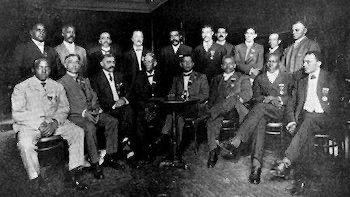
The National Negro Business League (August 23 & 24, 1900) was founded by Booker T. Washington in Boston. The league, which predated the US Chamber of Commerce by 12 years, strives to enhance the commercial and economic prosperity of the African American community. The NNBL was incorporated in 1901 in New York and established hundreds of chapters across the US. In 1966, the National Negro Business League was reincorporated in DC and renamed the National Business League.
Booker T. Washington believed that solutions to the problem of racial discrimination were primarily economic and that African American entrepreneurship was vital. He founded the league to further the economic development of African American businesses to achieve social equality in American society. Members in the league included small business owners, farmers, doctors, lawyers, craftsmen, and other professionals. The league maintained directories for all major US cities and incorporated African American contacts in numerous businesses.
Oftentimes, white business leaders addressed the National Business League at their annual conventions. Booker T. Washington himself kept contact with members of the white corporate elite, such as Andrew Carnegie and Julius Rosenwald, president of Sears, Roebuck, and Co.
The league established the Booker T. Washington Foundation in 1967 as a public, non-private operating foundation to serve as the research and development arm of the organization. It established the National Student Business League in 1974 as its collegiate division. Although the influence of the league declined since its peak in the early half of the 20th century, the organization still exists today and is headquartered in Atlanta with a second “federal” office in DC. The National Business League continues to promote economic enterprise and financial literacy for African Americans throughout the US and international trade with Africa and the African Diaspora. #africanhistory365 #africanexcellence
7 notes
·
View notes
Text
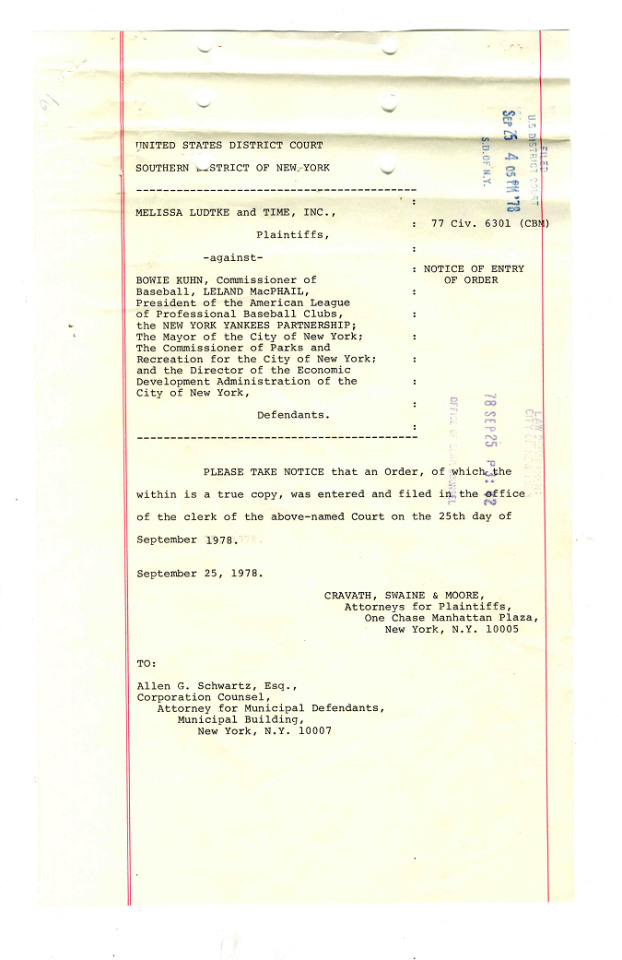

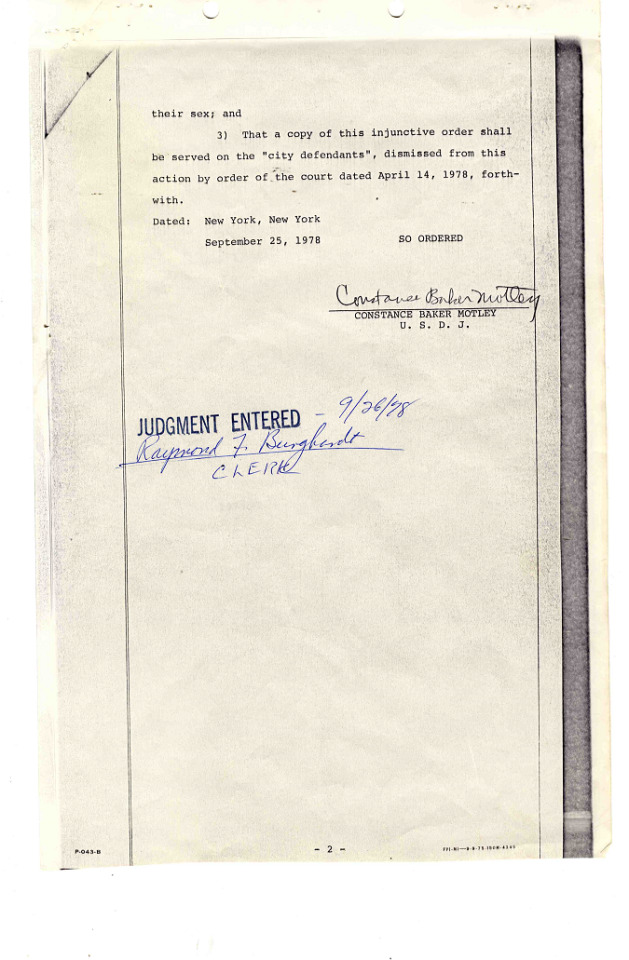
Order with Notice of Entry Judgment
"granting access to all accredited sports reporters to the locker room without regard to their sex"
Record Group 21: Records of District Courts of the United States Series: Civil Case Files File Unit: [Melissa Ludtke and Time, Incorporated v. Bowie Kuhn, Commissioner of Baseball, et al.]
[stamp] MICROFILM SEP 26 1978 [stamp] MICROFILM SEP 26 1978 58 UNITED STATES DISTRICT COURT SOUTHERN DISTRICT OF NEW YORK MELISSA LUDTKE and TIME, INC., Plaintiffs, -against- BOWIE KUHN, Commissioner of Baseball, LELEAND MacPHAIL, President of the American League of Professional Baseball Clubs, the NEW YORK YANKEES PARTNERSHIP; The Mayor of the City of New York; The Commissioner of Parks and Recreation for the City of New York; and the Director of the Economic Development Administration of the City of New York, Defendants. [stamp] U. S. DISTRICT COURT FILED SEP 25 1978 S. D. OF N. Y. 77 CIV. 6301 ORDER [handwritten] + Judgment In accordance with its opinion of this date, the court now ORDERS that plaintiffs' motion for summary judgment be and is hereby GRANTED, and defendants' motion for summary judgment is hereby DENIED. It is further ORDERED: 1) That defendants, their officers, agents, representatives, servants, employees, and all persons acting in concert and participation with them, be and they hereby are permanently enjoined from refusing to admit plaintiff Melissa Ludtke to the locker rooms of the clubhouses at Yankee Stadium solely on the ground of her sex; 2) That defendants shall adopt one of the al- ternative methods referred to in the court's opinion of this date to protect the privacy of ballplayers within the locker room while granting access to all accredited sports reporters to the locker room without regard to P-043-B 58 FPI.MI--9.9.75.150M.4345 their sex; and 3) That a copy of this injunctive order shall be served on the "city defendants", dismissed from this action by order of the court dated April 14, 1978, forth- with. Dated: New York, New York September 25, 1978 SO ORDERED [signature] Constance Baker Motley CONSTANCE BAKER MOTLEY U. S. D. J. [stamp] JUDGMENT ENTERED [handwritten] - 9/26/78 Raymond F. Burghardt CLERK P-043-B - 2 - FPI.MI--9.9.75.150M.4345 INDEX NO. 77 Civ. 6401 (CBM) UNITED STATES DISTRICT COURT SOUTHERN DISTRICT OF NEW YORK MELISSA LUDTKE and TIME, INC., Plaintiffs, -against- BOWIE KUHN, Commissioner of Baseball, et al., Defendants. ORDER WITH NOTICE OF ENTRY CRAVATH, SWAINE & MOORE Attorneys for Plaintiffs ONE CHASE MANHATTAN PLAZA NEW YORK, N. Y. 10005 Tel. No. HAnover 2-3000 [stamp] FILED U.S. DISTRICT COURT SEP 25 4 05 PM '78 S.D.OF N.Y. UNITED STATES DISTRICT COURT SOUTHERN DISTRICT OF NEW YORK MELISSA LUDTKE and TIME, INC., Plaintiffs, -against- BOWIE KUHN, Commissioner of Baseball, LELAND MacPHAIL, President of the American League of Professional Baseball Clubs, the NEW YORK YANKEES PARTNERSHIP; The Mayor of the City of New York; The Commissioner of Parks and Recreation for the City of New York; and the Director of the Economic Development Administration of the City of New York, Defendants. 77 Civ. 6301 (CBM) NOTICE OF ENTRY OF ORDER [stamp] LAW DEPARTMENT CITY OF NEW YORK 78 SEP 25 P3:42 OFFICE OF CORP COUNSEL PLEASE TAKE NOTICE that an Order, of which the within is a true copy, was entered and filed in the office of the clerk of the above-named Court on the 25th day of September 1978. September 25, 1978. CRAVATH, SWAINE & MOORE Attorneys for Plaintiffs, One Chase Manhattan Plaza, New York, N. Y. 10005 TO: Allen G. Schwartz, Esq., Corporation Counsel, Attorney for Municipal Defendants, Municipal Building, New York, N. Y. 10007
23 notes
·
View notes
Photo




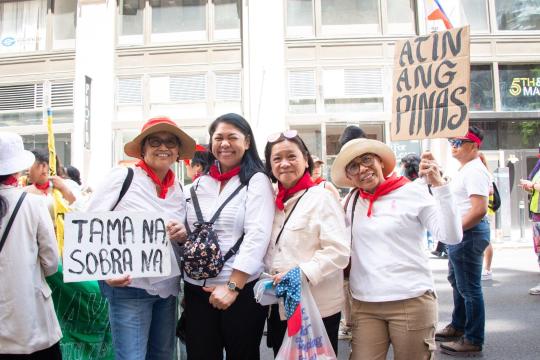



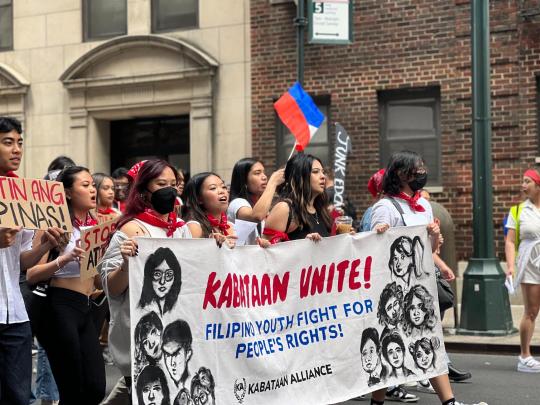

Last week, BAYAN-USA Northeast marched alongside the Northeast Coalition to Advance Genuine Democracy in the Philippines in the Philippine Independence Day Parade in New York City.
Today on the 125th Anniversary of Philippine Independence Day, we commemorate the ongoing struggle for human rights, national sovereignty, and genuine development!
It is false to recognize the Philippines’ independence when the Marcos Jr. administration continues the legacy of government puppetry to imperialist nations like the United States and China, fostering deals to cement U.S. military presence in our homeland through the Enhanced Defense Cooperation Agreement, and doing nothing to stop China’s economic expansion through encroaching mining corporations in the countryside, and naval ships in the West Philippine Sea.
Instead, we celebrate the history of resistance created by our people, which has resulted in the defeat of Spain by the Katipunan, the ousting of the Marcos Sr. regime, and the persevering fight against imperialism, feudalism, and bureaucrat capitalism by the national democratic movement. BAYAN-USA Northeast urges Filipinos across the region to join mobilizations and emphasize the demand for national industrialization and genuine agrarian reform, so that the Philippines may be free from foreign intervention and unfair economic and military agreements!
Atin ang Pinas! Magkaisa para sa karapatan, soberanya, at tunay na kaunlaran! Isulong ang pambansang demokrasya!
-- BAYAN USA Northeast, 12 Jun 2023
21 notes
·
View notes
Text
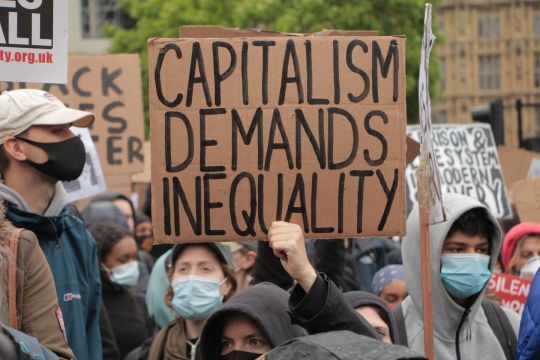
Virgil Alexander posted:
Forwarded to me by an executive accountant friend: WHO AND WHAT IS—BLACK LIVES MATTER?
Black Lives Matter might be viewed as a grassroots movement of concerned people gathering together. It is much more.
Black Lives Matter is a corporation whose real name is Black Lives Matter Global Network Foundation (BLMGNF). (Yep, it's one of those capitalistic corporations they profess to hate.)
The following information is on their web site. It's a nationwide corporation! BLMGNF has chapters in Boston, Chicago, Washington DC, Denver, Detroit, Los Angeles, Lansing, Long Beach, Memphis, Nashville, New York City, Philadelphia, South Bend and in Canada in Toronto, Vancouver, and Waterloo. (If you were impressed by how all those recent riots erupted simultaneously from a grassroots movement--well, maybe it's not so grassroots.)
BLMGNF is a not-for-profit corporation--but it's not tax exempt, so donations are not tax deductible. Except if you go to its website and want to donate, you're transferred to 'ActBlue Charities' which will take your donation, give you a tax deduction, and then distribute the money you gave to BLMGNF. Sort of . . .
What is ActBlue?
The following is taken directly from ActBlue’s web page: “Our platform is available to Democratic candidates and committees, progressive organizations, and nonprofits that share our values for no cost besides a 3.95% processing fee on donations. And we operate as a conduit, which means donations made through ActBlue to a campaign or organization are considered individual donations.”
ActBlue consists of three parts: ActBlue Charities facilitates donations to left-of-center 501(c)(3) nonprofits; Act Blue Civics is its 501(c)(4) affiliate; ActBlue is a 527 Political Action Committee. These three have raised over $5 billion in the sixteen years since it started. If it's 3.95% transaction fee has indeed been applied to all donations, that equates to over $197 million!
ActBlue is thus a Democratic Party front affiliated with BLMGNF. If only it was that simple and stopped there.
Per Business Insider Australia: “ActBlue . . . distributes the money raised to Thousand Currents, which is then granted to Black Lives Matter.”
So, what, you ask, is Thousand Currents (formerly the International Development Exchange)?
Again, per Business insider Australia: “Thousand Currents is a 501(3)(c) non-profit that provides grants to organizations that are . . . developing alternative economic models." (Is anarchy now an alternative economic model?)
"Thousand Currents essentially acts as a quasi-manager for Black Lives Matter: ‘It provides administrative and back office support, including finance, accounting, grants management, insurance, human resources, legal and compliance,’ (Executive Director Solome) Lemma said.” (Finance, insurance, human resources, legal and compliance? It sounds like General Motors!)
What is the significance of the above?
Black Lives Matter is not some fly-by-night fad that is going to loot and destroy and then disappear into the ash heap of history. It's a multi-corporation, big business that is heavily associated with and supports the Democratic Party--and it's here to stay. Arguing whether Black Lives or All Lives Matter is meaningless and distracts from what it's trying to achieve. It's a left-wing political movement that will have a significant impact on Democratic Party programs for the foreseeable future.
Socialism and Communism are intimately linked to these efforts. The U.S. Constitution and especially the Bill of Rights have no place in their plans. Patrisse Cullors,one of Black Lives Matter’s cofounders is widely quoted as saying, “We are trained Marxists.”
The president of Greater New York Black Lives Matter said that if the movement fails to achieve meaningful change during nationwide protests, they will “burn down this system.” Not the peaceful change we celebrate under our Constitution but violent change. For those of us who like our Constitution, this is a challenge thrown directly in our faces.
If you've been wondering why politicians have danced around criticizing Black Lives Matter, now you know.
9 notes
·
View notes
Text
Arthur Tress
Born in Brooklyn, New York, on November 24, 1940, Arthur Tress began his first camera work as a teenager in the surreal neighborhood of Coney Island where he spent hours exploring the decaying amusement parks. Later, during five years of world travel, mostly in Asia and Africa, he developed an interest in ethnographical photography that eventually led him to his first professional assignment as a U.S. government photographer recording the endangered folk cultures of Appalachia.
Seeing the destructive results of corporate resource extraction, Tress began to use his camera to raise environmental awareness about the economic and human costs of pollution. Focusing on New York City, he began to photograph the neglected fringes of the urban waterfront with a straight documentary approach. This gradually evolved into a more personal mode of “magic realism” combining improvised elements of actual life with stage fantasy that became his hallmark style of directorial fabrication. In the late 1960s Tress was inspired to do a series based upon children’s dreams that combined his interests in ritual ceremony, Jungian archetypes, and social allegory. Later bodies of work dealing with the hidden dramas of adult relationships and the reenactments of male homosexual desire evolved from this primarily theatrical approach.










44 notes
·
View notes
Text

Toronto in the 1900s was a different city from the one we know today.
The center of business had moved west of the historical Town of York site and the skyline was undeveloped.
The tallest structures were the Temple Building at 10 stories and the Trader’s Bank Building at 15 stories.
A new downtown to the west of Yonge and King Streets was built. The City of Toronto moved into a new City Hall, built at the head of Bay Street at Queen Street.
Much of this new downtown was destroyed in the Great Toronto Fire of 1904, but it was quickly rebuilt, with new taller buildings.
South of downtown, the railways dominated most of the lands. A new viaduct was built to carry the main lines and eliminate the many at-level crossings.
A single Union Station was built to replace the several railway stations of the rail lines. It sat empty for a while over disagreements between the government and the rail companies.
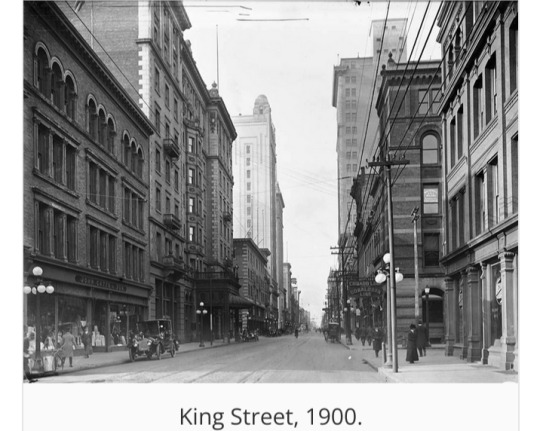
In the late nineteenth century, Toronto welcomed the rise of Victorian architecture, as well as many of its revival styles.
This style of architecture was thought to be more modern, unique and creative than its successor, characterized by steep gabled roofs, round angles, towers, turrets and dormers, shapely bay windows, stained glass, centric carved woodwork, and bright colored paneling.
This style lent itself well to narrower lots, and thus, Victorian-style housing was most abundant in the city’s traditionally middle-class neighborhoods where individual properties were smaller, most notably Cabbagetown, Trinity-Bellwoods, Parkdale, and The Annex.
These neighborhoods held some of the largest collections of Victorian houses in North America.
Specifically, houses constructed in the Annex developed an individual iteration of the Victorian style, called the “Annex Style House.”
This style contained a variety of diverse and eclectic elements borrowed from many different styles.
Most distinctively, these houses were built of a mix of brick and sandstone, turrets, domes, and decorative ornamentation.
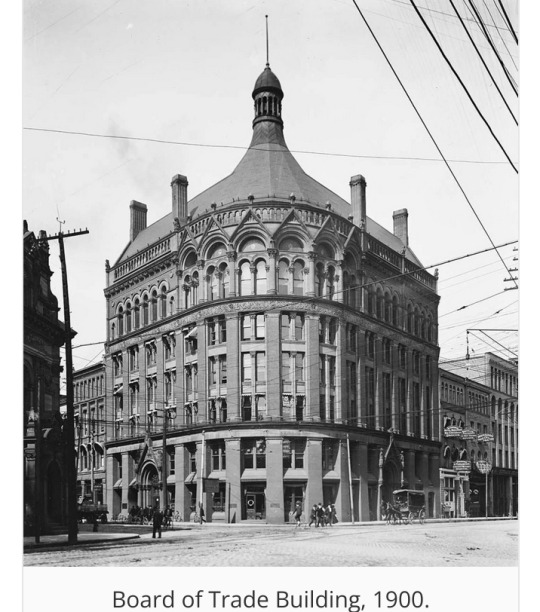
The city received new European immigrant groups beginning in the late 19th century into the early 20th century, particularly Germans, French, Italians, and Jews.
They were soon followed by Russians, Poles, and other Eastern European nations, in addition to the Chinese entering from the West.
As the Irish before them, many of these migrants lived in overcrowded shanty-type slums, such as “the Ward,” which was centered on Bay Street, now the heart of the country’s Financial District.
As new migrants began to prosper, they moved to better housing in other areas, in what is now understood to be succession waves of settlement.
Despite its fast-paced growth by the 1920s, Toronto’s population and economic importance in Canada remained second to the much longer-established Montreal, Quebec.

The Great Depression of the 1930s reversed the employment trend, with approximately one-fourth of the Toronto population unemployed and caused severe financial problems for suburban Toronto.
Capital debt payments could not be met and expenditure on public services—sewage and piped water supply in places remote from the lake, for example—had to be postponed.
However, World War II’s demands for war supplies and soldiers soon changed the employment picture.
Following the war, and into the 1960s, times were prosperous throughout North America.
Toronto’s economy diversified and boomed, greatly altering the cultural and spatial pattern of the city.
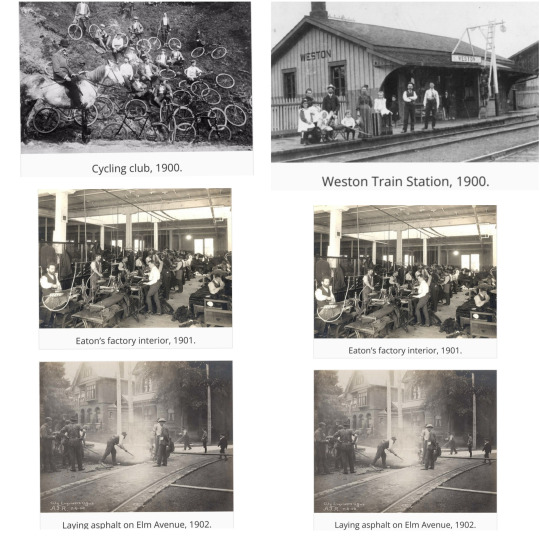
Other factors after the war included the baby boom, demand for single-family dwellings, and the proliferation of the automobile.
Suburban sprawl was assisted by the increase in road networks and freeways, thereby consuming some of the best agricultural land in the region.
By 1953, a reorganization of local government had been created, along with the Corporation of Metropolitan Toronto, in an attempt to control development in the surrounding regions.
Suburban growth continued. In 1966, new City of Toronto boundaries were drawn, amalgamating 13 communities, with the Metropolitan government still in place.
By the 1976 census, Toronto passed Montreal to become the largest city in Canada, and the gap between these two cities continued to grow.
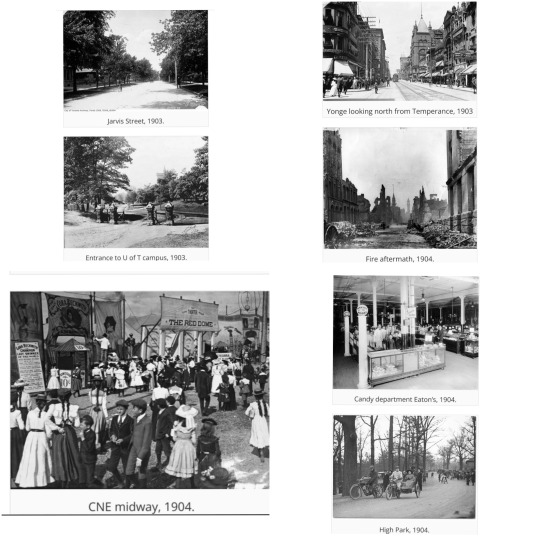

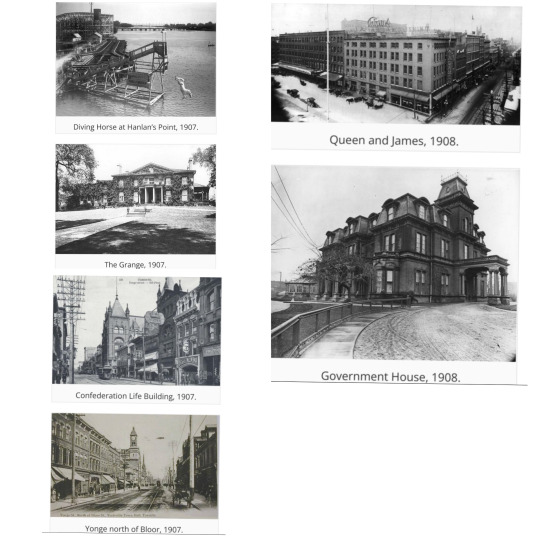


(Photo credit: City of Toronto Archives / BlogTO / Wikimedia Commons / Britannica / Flickr).
Updated on: February 6, 2023
#Toronto#1900s#20th century#Great Toronto Fire of 1904#Victorian architecture#Annex Style House#19th century#Great Depression of the 1930s#Rare Historical Photos#vintage photos#Victorian houses
14 notes
·
View notes
Text
NYCIDA Advances Financial Assistance to Renovate Long Island City’s Metropolitan Building into Small-Scale Manufacturing Hub
Currently Under-Utilized, the Metropolitan Building Will Be Redeveloped Into a Mixed-Use Building for Manufacturing and Light Industrial Uses
Project Aims to Boost Manufacturing in a Key Industrial Business Zone
The New York City Economic Development Corporation (NYCEDC) and the New York City Industrial Development Agency (NYCIDA) today announced the closing of a transaction to provide…
0 notes
Text
Message from Brian
Director’s Report from Poland

As we look ahead to the 2025 World Canals Conference next year in Buffalo, our overseas travel earlier this summer to join international peers gathered in Bydgoszcz, Poland for the 2024 conference has reaffirmed that New York State is not alone in either the myriad of challenges or opportunities shared by operators of canals and inland waterway systems around the globe.

Historic Bydgoszcz Canal
In June, I was joined by Executive Deputy Director Rebecca Hughes and Eastern Division Canal Engineer Joe Moloughney, part of a diverse private/public New York delegation attending the four-day conference in Poland’s North-Central region along the confluence of the Brda and Vistula rivers. More than 200 delegates from 15 countries were welcomed to the host city beginning with a weekend water festival alongside the historic Bydgoszcz Canal, setting the tone for a robust schedule of conference sessions and excursions in the week ahead of us.

Bydgoszcz Community Water Festival
During the week, Rebecca and Joe presented technical papers as part of a series of conference breakout sessions. They represented New York State, Canals and NYPA exceptionally well by sharing some of New York’s most challenging operational issues on the Canal system: aquatic invasive species, flood mitigation, and earthen embankment management.
Mitigating the Spread of Invasive Species

Joe Moloughney
Delegates received an in-depth overview of measures the Canal Corporation has implemented – working in cooperation with state and local entities – to combat the threat of the Round Goby on the Champlain Canal. As is true for many European inland waterways, the Champlain connects into larger bodies of water (Lake Champlain) and borders other countries, states and managing authorities (Canada, Vermont, and the Lake Champlain Basin Program), thus elevating public concern for the potential spread of the destructive Goby into these adjacent territories. Joe explained that preventative measures put into place along the Champlain are not without challenges to our Canal workforce or some inconvenience to the boating public, including navigation delays caused by a limited schedule of lock passage times (three daily) and double draining of the first four of the Champlain’s 11 locks.
Revitalizing New York’s Historic Canal for the Third Century of Operation

Rebecca Hughes
Supporting the conference central theme of “Intersection of Environment and Economic Development,” Rebecca’s presentation detailed the Canal Corporation’s approach to public relations on environmental issues. This includes vegetation management under our Earthen Embankment Integrity Program and the impact of the increased intensity of high-water events along the Canal through the Upstate Flood Mitigation Task Force.
Like so many topics discussed in Bydgoszcz, challenges related to vegetation management and flood mitigation were common themes among our international waterway peers. Both overseas and at home, increased financial support for canals is essential. Rebecca underscored Governor Hochul’s commitment of new funding in the current New York budget to move forward with key elements of our flood mitigation and embankment management action plans.
Celebrating Poland’s History, Culture, and Architecture

Wine Country, Przy Talerzku Vineyards, Topolino

Old Palace, Ostromecko

Musicians outside the New Palace, Ostromecko

Beyond the benefit of networking and information sharing of the conference sessions, there was also time to enjoy the history, culture, and unique beauty of this eastern European region. A special highlight was the conference evening gala dinner program hosted at the mid-18th century Mostowski Palace in Ostromecko, in the Vistula Valley just outside Bydgoszcz.
‘Passing the Torch’

Bydgoszcz Mayor Rafat Bruski makes the hand-off to our New York team
During conference closing ceremonies Bydgoszcz Mayor Rafat Bruski gave a warm send off to all, including the requisite passing of the World Canals Conference “torch” on to New York State for our hosting duties in 2025. In this case, the mayor presented us with a replica ship’s wheel inscribed with the international navigation coordinates of Bydgoszcz and Buffalo

A special video greeting and message from Gov. Kathy Hochul to conference delegates in Bydogoszcz
On behalf of our entire New York delegation, I was proud to thank Mayor Bruski and our international colleagues for a truly memorable week in his city and introduce a special video message from Governor Kathy Hochul inviting our international partners and friends to reconvene with us next year in New York’s Queen City for WCC 2025.

Bydogoszcz World Canals Conference attendees, Rother's Mill Island Conference Center
I invite you to see what New York has in store for the world next year at www.WWC2025Buffalo.com.
Get ready!

0 notes
Text
The Magic Behind Orlando’s Booming Real Estate Market
Orlando, famously known for its enchanting theme parks and vibrant tourism industry, has been experiencing a remarkable surge in its real estate market. This booming sector has captured the attention of investors, homeowners, and real estate enthusiasts alike. The city’s strategic location, economic growth, and lifestyle offerings contribute to its attractiveness. In this article, we will delve into the factors driving Orlando’s real estate market, the emerging trends, and what the future holds for this dynamic city.
Economic Growth and Job Market
Orlando’s economic landscape has undergone significant transformation over the past decade. The city’s diversification beyond tourism has played a crucial role in its real estate market’s expansion. Orlando is home to a burgeoning tech industry, healthcare sector, and a thriving start-up ecosystem. The presence of major corporations and a robust job market has attracted a diverse workforce, increasing demand for housing.
Tech companies, in particular, have found Orlando to be an appealing destination due to its lower cost of living compared to other tech hubs like San Francisco and New York. This influx of tech professionals has spurred the development of modern residential properties, catering to the needs of young professionals and families.
Selling a House in Orlando
For homeowners looking to sell house Orlando, the current market conditions are highly favorable. The strong demand for properties, coupled with limited inventory, has created a seller’s market. Homeowners can benefit from competitive offers and quick sales, often receiving prices above their initial asking prices. Real estate agents in Orlando are equipped with the expertise to navigate this dynamic market, ensuring that sellers achieve the best possible outcomes.
Population Growth and Demographics
Orlando’s population has been steadily growing, making it one of the fastest-growing cities in the United States. The city’s appeal extends beyond its job market; its warm climate, vibrant cultural scene, and family-friendly environment make it a desirable place to live. The population growth has created a robust demand for housing, leading to the development of new residential communities and revitalization of older neighborhoods.
The demographic makeup of Orlando is diverse, with a mix of young professionals, families, and retirees. This diversity has influenced the real estate market, with a variety of housing options available to meet the needs of different demographic groups. From modern downtown apartments to spacious suburban homes, Orlando offers something for everyone.
Real Estate Investment Opportunities
Orlando’s real estate market presents lucrative investment opportunities. The city’s steady population growth and strong rental demand make it an attractive destination for real estate investors. Additionally, Orlando’s relatively affordable property prices compared to other major cities provide a high potential for appreciation.
Investors have shown particular interest in short-term rental properties, leveraging Orlando’s tourism industry. Vacation rentals near popular attractions such as Walt Disney World and Universal Studios have become a profitable venture. This trend has been facilitated by platforms like Airbnb, allowing investors to capitalize on the city’s constant influx of tourists.
Infrastructure and Development Projects
Infrastructure development has been a driving force behind Orlando’s real estate boom. The city has invested heavily in transportation projects, making it more accessible and convenient for residents and visitors. The expansion of the Orlando International Airport, improvements in public transportation, and the construction of new highways have enhanced connectivity within the city and beyond.
One notable development is the SunRail commuter train, which has improved accessibility to various parts of the city and surrounding areas. This has not only eased commuting for residents but also opened up new areas for residential development. The city’s commitment to infrastructure improvements has significantly contributed to the attractiveness of its real estate market.
Lifestyle and Amenities
Orlando’s lifestyle offerings are a major draw for residents and potential homeowners. The city is renowned for its world-class entertainment options, including theme parks, theaters, and cultural festivals. Beyond the glitz and glamour of its tourism industry, Orlando boasts beautiful parks, golf courses, and recreational facilities, making it an ideal place for outdoor enthusiasts.
The city’s dining scene is equally impressive, with a wide range of culinary experiences reflecting its diverse population. From fine dining restaurants to food trucks offering global cuisines, Orlando caters to all tastes. Additionally, the city’s shopping districts and entertainment hubs provide ample opportunities for leisure and relaxation.
The Role of Education and Healthcare
Education and healthcare are critical factors influencing Orlando’s real estate market. The city is home to several reputable educational institutions, including the University of Central Florida, one of the largest universities in the United States. The presence of top-tier schools and universities has made Orlando an attractive destination for families seeking quality education for their children.
Moreover, Orlando’s healthcare sector is robust, with numerous hospitals, clinics, and research facilities. The availability of high-quality healthcare services is a significant consideration for homebuyers, contributing to the city’s appeal as a place to settle down.
The Impact of Remote Work
The rise of remote work has had a profound impact on Orlando’s real estate market. As more companies embrace flexible work arrangements, employees are no longer tied to living near their workplaces. This shift has led to an increased interest in Orlando, where residents can enjoy a high quality of life while working remotely.
The city’s affordable housing market, combined with its desirable lifestyle amenities, has made it a popular choice for remote workers relocating from more expensive cities. This trend has further fueled demand for housing, driving up property values and spurring new developments.
Future Outlook
The future of Orlando’s real estate market looks promising. The city’s continuous economic growth, population influx, and strategic development projects are expected to sustain its real estate boom. As Orlando evolves, it will likely attract more investors, homebuyers, and businesses, further enhancing its reputation as a prime real estate destination.
Sustainable development initiatives and smart city planning will play a crucial role in maintaining the city’s appeal. Efforts to balance growth with environmental conservation and infrastructure improvements will ensure that Orlando remains an attractive place to live, work, and invest.
Conclusion
Orlando’s booming real estate market is a testament to the city’s vibrant economy, diverse population, and strategic growth initiatives. The magic behind this success lies in a combination of factors, including economic diversification, infrastructure development, lifestyle amenities, and a thriving job market. As Orlando continues to grow and evolve, its real estate market is poised for sustained success, offering ample opportunities for investors and homeowners alike. Whether you’re looking to invest, relocate, or simply explore the possibilities, Orlando’s real estate market holds immense potential.
0 notes
Text
Mission Briefing From Agent Brown (Program Vicar-1)
Royal Irish Navy: Labor control forces, the label of "Irish" in the Hebrew Geneology listings; police labor.
Canadian Mounted Patrol: Influence and art media, through call centers and backtraced lines; sum data, held in computers, through felony invoices on recording sheets of prior imprinted felony against controlled substances acts, or support groups thereof.
B'nai B'rith: The sheriffs division, those hired at mercenary private detective to enforce law no longer in status or force or removed, through any politician, worldwide, to be enforced anywhere, worldwide.
Counter Terror: The Quaker Oats fund, to study factories and warehouses and grain silos, to export cereals productions overseas to train workforces to produce armored warfare and vehicles status produce.
Goldman-Sachs: A talent organization out of Broadway, specializing at the removal of negligent sectors of urban tract, through art movements, encouraging immigration by homosexuals, those practicing Lutheran logic; sterile men, by pituatary dysfunction, and barren women, through improper stance of lotus, scoliosis.
Saks Fifth Avenue: Sales of chemicals similar to Rohypnol, however herbal, and in terms of texture beneath nose, often used by CVS corporate executives out of Coens, Hitlers, and Murdochs.
Macy's: Hedge funds basis out of Rockefeller Center in Manhattan, New York City; used for the common coverage of any number of wars overseas with American involvement, to export illicit substance as common industrialized labor for pogrom of sectors of collegiate study; "genocide", actually, an anthropological study, in produce of queer labor, Protestants.
D-Company: Extension of Silk Road and East Indies Company, the holding share in Dutch Country, Boer South Africa, and Uighur West China. Used in calculation of media movements and script shares, for particular breeding of assassins, out of a single economic role, held by the main character's child; however, if matching proper byline, now hired into contract by necessary partnership organization out of military ally's accounts.
Delta Blue: British Airways overlay, into Thailand, out of Delhi and Amsterdam. The traffic in sex commerce, through inmates held in Indochina; used as specialists in technical sciences, in any commercial social science entering the common media as a secondary function of commercial product.
Israeli Defense Forces: Neo-Nazi forces held in reserve by Lutheran Iranian alliance, out of Judea and Samaria; held as "Arabs", actually Americans, Hamas, hostage, to sport fight from World War 2 forces ruled as "Hebrum"; Jewish-Americans, as converted to Christian Arabianism, and slurred as "Muslims", homosexuals, without being aware of such attachment.
Paramilitary Reconnaissance: Mercenary forces out of Italy, "Mafiaso", dealing in a third party isosceles triangle for a foreign broker, for development of a market by shift of relationship in a simple thread and peg, on a pair of logical points out of fiction discussed by product imported; Kabuki theater in Japan, prior to Douglas MacArthur.
Israeli Air Force: Training programs and pilot programs as being the same, instead of the foreign model, of an Air Force program as intelligence forces, and an academy being for flight of civilian and military craft. Used as munitions export, through mercenaries recruited out of the entertainment community.
0 notes
Text

Malcolm Anthony Smith (August 9, 1956) is a former Democratic acting Lieutenant Governor of New York under Governor David Paterson and simultaneously the New York State Senate Majority Leader.
He held the office of Lieutenant Governor for five months (January 7, 2009 to June 8, 2009). He lost his position after Senators Pedro Espada Jr. and Hiram Monserrate, both Democrats, joined with thirty Republican state senators in voting to replace him as Majority Leader and Lt. Governor. Espada cited his frequent support for conservative causes and politicians as the reason for his vote. He retained his title of Temporary President of the Senate.
He began his political career representing the 10th district in the New York State Senate (2000-02) following a special election. He represented Senate District 14 (2003-14). He served as New York State Senate Majority Leader (2009) and served as Temporary President of the New York State Senate (2009-10). He is the first African American to hold those leadership positions. He was defeated in the Democratic primary.
He was born in Queens. He earned his BS in Business Administration from Fordham University and his MBA in Finance/Operations Management from Adelphi University. He was a city hall assistant to former New York City Mayor Edward Koch. He was chief aide to former city council member Archie Spigner and worked for the Challenge to Minority Banks Program. He worked as a procurement manager for the New York City Office of Economic Development (1985–86) and he was a district manager for Congressman Floyd H. Flake (1986-91). He founded Smith Development Corporation, a real estate development company, and served as company president of the Smith-Darmon Group Developers.
He is married to Michele Lisby-Smith. They have three children. He has a son.
He and four others were arrested by the FBI on Federal corruption charges. The first trial ended in a mistrial. At the second trial, he was convicted of conspiracy, wire fraud, travel act bribery, and extortion and to seven years in prison. #africanhistory365 #africanexcellence
0 notes
Text
Power Players: Top Executives Shaping New York's Business Landscape
New York City, the Big Apple, is a global center for commerce and innovation. At the helm of its thriving industries are some of the most influential and accomplished executives in the world. These leaders drive growth, navigate challenges, and leave their mark on the ever-evolving business landscape. Let's delve into the diverse pool of Top Executives in New York currently shaping New York's business scene.
Financial Titans: Steering the Flow of Capital
New York has long been a financial powerhouse, and this tradition continues with visionary leaders in banking and investment. John Sergides, CEO of MUFG Investor Services, exemplifies this. Under his guidance, the company surpassed a record $1 trillion in assets, solidifying its position in the global alternative investment management industry.
Looking beyond traditional finance, we see leaders like Matt Baer, CEO of Stitch Fix. Baer is transforming the retail experience by implementing innovative strategies to streamline the C-suite and labor structure, making Stitch Fix a more efficient and competitive player in the e-commerce fashion market.
Tech Trendsetters: Building the Future
New York City is a hotbed for technological innovation, and its tech sector is brimming with talented executives. Stephanie Choi, Co-founder and COO of Sawyer, is a prime example. Sawyer is a leading AI-powered real estate brokerage platform, and Choi's expertise is instrumental in its growth and success.
Another key figure is Xiaodi Zhang, Chief Product Officer at 1stDibs. 1stDibs is a premier online marketplace for luxury vintage furniture and design. Zhang's product leadership plays a crucial role in curating a seamless user experience and maintaining 1stDibs' position at the forefront of the online luxury market.
Beyond the Boardroom: Diverse Leadership Makes a Difference
New York's business scene is becoming increasingly diverse, with a growing number of prominent female and minority executives. Kumsal Bayazit, CEO of JPMorgan Chase Turkey, is a shining example. Bayazit's leadership has been instrumental in JPMorgan Chase's expansion into new markets and her success paves the way for future generations of female leaders.
Devra Prywes, Chief Product Officer at Applicaster, is another inspiring figure. Applicaster is a leading mobile app development platform, and Prywes' product expertise is key to its success. Her presence challenges the traditional image of leadership in the tech industry, promoting diversity and inclusion in the C-suite.
The Impact of Top Executives: Shaping the City's Future
The influence of top executives extends far beyond their companies. They play a vital role in shaping New York City's economic vitality, its reputation as a center for innovation, and its ability to attract and retain top talent.
These leaders are not just driving corporate success; they are also making significant contributions to social causes and philanthropic initiatives. Their dedication to the city's well-being creates a ripple effect that benefits all New Yorkers.
Looking ahead, New York's business landscape promises to be even more dynamic and competitive. The city will undoubtedly continue to attract some of the most talented and visionary executives who will lead the way in shaping the future of business not only for New York but for the global stage.
1 note
·
View note
Text
Web Design Agency NYC
Over the past ten years, there has been an exponential rise in the web design agency NYC. There are multiple reasons for this:
Business Hub: With innumerable startups, small firms, and corporations based there, New York City is a global center of business. The necessity for expert web design services is fueled by these businesses' requirement for strong online presences in order to remain competitive.
Tech Ecosystem: Web design firms find great success in the city's booming tech sector. NYC promotes an innovative and collaborative culture through its many tech conferences, meetings, and incubators.
Diverse Market: Web design firms must serve a variety of businesses and audiences due to NYC's diverse population and global economic links, which encourages innovation and adaptation.
The agency's approach is centered on collaboration and communication. They work closely with clients to understand their brand, their target audience, and their specific needs, then translate that into a website that aligns with their goals. This could include features like custom post types, e-commerce integration, or advanced content management capabilities.
The agency's process begins with a deep understanding of the client's target audience and their browsing habits. They then use this information to develop a responsive design that provides an optimal user experience, regardless of the device being used. This attention to detail has earned APS Marketing a reputation for creating websites that are not only beautiful but also highly effective in driving engagement and conversions.
The web design companies in New York City are leading the way in digital innovation, producing websites that are just as vibrant and varied as the city. These companies have the know-how and inventiveness required to thrive in the cutthroat online environment of today, whether you're a local startup trying to build your online presence or an established brand in need of a digital makeover. These companies are assisting companies of all sizes in leaving their mark on the digital landscape by fusing state-of-the-art technology with New York City's distinct creative spirit.
The top web design companies in NYC are aware that a successful website is a dynamic, living thing. What qualities should a long-term relationship possess?
continuous Support and Maintenance: Reputable companies provide continuous support and maintenance services to make sure your website stays safe, current, and operating at its best.
SEO Optimization: In NYC, being visible in organic searches is essential. Prominent agencies employ tactics to raise your website's search engine rating because they comprehend SEO best practices.

0 notes
Text
Exploring the Dynamic World of Chicago Video Production Companies
Creative Storytelling at Its Best: Chicago Video Production Companies
Chicago video production companies are on the coronary heart of modern storytelling, merging innovation with artistry to craft compelling narratives. These Chicago video production companies are seemed for their capacity to deliver visually beautiful and emotionally resonant films that seize the essence of their topics. Whether it’s for advertising, amusement, or training, Chicago video production companies carry testimonies to life with extraordinary ability.
Pioneering Innovation and Collaboration: Chicago Production Companies
Innovation and collaboration are the cornerstones of Chicago production companies. By embracing the modern technology and fostering robust partnerships with customers, Chicago production companies create groundbreaking content material that stands proud in a crowded market. These Chicago production companies aren’t simply provider providers; they may be creative companions committed to bringing their customers’ visions to life with ingenuity and precision.
Film Production Companies in Chicago: Champions of Cinematic Excellence
Because film production companies in Chicago are committed to preserving the city’s film history and traditions, they are in a unique position to keep the tradition of filming in Chicago going strong. Chicago has several places, right from its Skyline to the varied colored neighborhoods that provides great visible concept to firms in the film producing companies in Chicago. This town has been the putting for many iconic movies, and its film production Companies in Chicago are committed to maintaining and improving this proud subculture.
Tailored Services for Every Need: Chicago Video Production Companies
What units Chicago video production companies apart is their willpower to presenting tailor-made offerings that meet the precise wishes of every purchaser. From conceptualization to put up-manufacturing, these Chicago video production companies offer customized solutions that ensure every venture achieves its particular dreams. Whether it’s a slick corporate video, a heartfelt documentary, or a fascinating social media campaign, Chicago video production companies specialists deliver excellence whenever.
A Broad Spectrum of Services: Chicago Production Companies
Chicago production companies are distinguished by their versatility. Chicago production companies provide a huge range of services past video manufacturing, which include stay event management, multimedia installations, and tv production. This huge spectrum of Chicago production companies services enables them to deal with diverse tasks, presenting complete solutions that cater to the various wishes in their clients.
Economic and Cultural Contributions: Film Production Companies in Chicago
The film production Companies in Chicago is a major monetary motive force, developing jobs and assisting nearby agencies. Beyond the financial blessings, these film production Companies in Chicago make a contribution to the town’s cultural vibrancy with the aid of telling stories that mirror Chicago’s specific character and diversity. Film production Companies in Chicago help positioned Chicago on the worldwide stage, attracting tourism and investment even as enriching the neighborhood lifestyle.
Contact Us:
Email: [email protected]
Phone: 646–417–5330
Address: 54 W 40th St New York, NY 10018
#chicago video production companies#chicago production companies#film production companies in Chicago#ChicagoProduction#FilmInChicago#ChicagoVideo#CreativeChicago#ChicagoMedia#VideoProductionChicago#ChicagoFilmmakers#FilmProductionChicago#InnovativeChicago#ChicagoTalent#CinematicChicago#ChicagoBusiness#ChicagoArt#WindyCityFilms#ChicagoCreatives
0 notes
Text
All in the family
New Post has been published on https://sunalei.org/news/all-in-the-family/
All in the family

It’s no news that companies use money to influence politics. But it may come as a surprise to learn that many family-owned firms — the most common form of business in the world — do not play by the same rules. New research by political science PhD candidate Sukrit Puri reveals that “family businesses depart from the political strategy of treating campaign donations as short-term investments intended to maximize profitmaking.”
Studying thousands of such firms in India, Puri finds that when it comes to politics, an important influence on political behavior is ethnic identity. This in turn can make a big impact on economic development.
“If family businesses actually think about politics differently, and if they are the most common economic actors in an economy, then you break channels of accountability between a business and the government,” says Puri. “Elected officials may be less likely to deliver effective policies for achieving economic growth.”
Puri believes his insights suggest new approaches for struggling economies in some developing countries. “I’d like to get governments to think carefully about the importance of family firms, and how to incentivize them through the right kinds of industrial policies.”
Pushing past caricatures
At the heart of Puri’s doctoral studies is a question he says has long interested him: “Why are some countries rich and other countries poor?” The son of an Indian diplomat who brought his family from Belgium and Nepal to the Middle East and New York City, Puri focused on the vast inequalities he witnessed as he grew up.
As he studied economics, political science, and policy as an undergraduate at Princeton University, Puri came to believe “that firms play a very important role” in the economic development of societies. But it was not always clear from these disciplines how businesses interacted with governments, and how that affected economic growth.
“There are two canonical ways of thinking about business in politics, and they have become almost like caricatures,” says Puri. One claims government is in the pocket of corporations, or that at the least they wield undue influence. The other asserts that businesses simply do governments’ bidding and are constrained by the needs of the state. “I found these two perspectives to be wanting, because neither side gets entirely what it desires,” he says. “I set out to learn more about how business actually seeks to influence, and when it is successful or not.”
So much political science literature on business and politics is “America-centric,” with publicly listed, often very large corporations acting on behalf of shareholders, notes Puri. But this is not the paradigm for many other countries. The major players in countries like South Korea and India are family firms, big and small. “There has been so little investigation of how these family businesses participate in politics,” Puri says. “I wanted to know if we could come up with a political theory of the family firm, and look into the nature of business and politics in developing economies and democracies where these firms are so central.”
Campaign donation differences
To learn whether family businesses think about politics differently, Puri decided to zero in on one of the most pervasive forms of influence all over the world: campaign donations. “In the U.S., firms treat these donations as short-term investments, backing the incumbent and opportunistically switching parties when political actors change,” he says. “These companies have no ideology.” But family firms in India, Puri’s empirical setting, prove to operate very differently.
Puri compiled a vast dataset of all donations to Indian political parties from 2003 to 2021, identifying 7,000 unique corporate entities donating a cumulative $1 billion to 36 parties participating in national and state-level elections. He identified which of these donations came from family firms by identifying family members sitting on boards of these companies. Puri found evidence that firms with greater family involvement on these boards overwhelmingly donate loyally to a single party of their choice, and “do not participate in politics out of opportunistic, short-term profit maximizing impulse.”
Puri believes there are sociological explanations for this unexpected behavior. Family firms are more than just economic actors, but social actors as well — embedded in community networks that then shape their values, preferences, and strategic choices. In India, communities often form around caste and religious networks. So for instance, some economic policies of the ruling Bharatiya Janata Party (BJP) have hurt its core supporters of small and medium-sized businesses, says Puri. Yet, these businesses have not abandoned their financial support of the BJP. Similarly, Muslim-majority communities and family firms stick with their candidates, even when it is not in their short-term economic best interest. Their behavior is more like that of an individual political donor — more ideological and expressive than strategic.
Engaged by debate
As a college first-year, Puri was uncertain of his academic direction. Then he learned of a debate playing out between two schools of economic thought on how to reduce poverty in India and other developing nations: On one side, Amartya Sen advocated for starting with welfare, and on the other, Jagdish Bhagwati and Arvind Panagariya argued that economic growth came first.
“I wanted to engage with this debate, because it suggested policy actions — what is feasible, what you can actually do in a country,” recalls Puri. “Economics was the tool for understanding these trade-offs.”
After graduation, Puri worked for a few years in investment management, specializing in emerging markets. “In my office, the conversation each day among economists was just basically political,” he says. “We were evaluating a country’s economic prospects through a kind of unsophisticated political analysis, and I decided I wanted to pursue more rigorous training in political economy.”
At MIT, Puri has finally found a way of merging his lifelong interests in economic development with policy-minded research. He believes that the behavior of family firms should be of keen concern to many governments.
“Family firms can be very insular, sticking with old practices and rewarding loyalty to co-ethnic partners,” he says. There are barriers to outside hires who might bring innovations. “These businesses are often just not interested in taking up growth opportunities,” says Puri. “There are millions of family firms but they do not provide the kind of dynamism they should.”
In the next phase of his dissertation research Puri will survey not just the political behaviors, but the investment and management practices of family firms as well. He believes larger firms more open to outside ideas are expanding at the expense of smaller and mid-size family firms. In India and other nations, governments currently make wasteful subsidies to family firms that cannot rise to the challenge of, say, starting a new microchip fabricating plant. Instead, says Puri, governments must figure out the right kind of incentives to encourage openness and entrepreneurship in businesses that make up its economy, which are instrumental to unlocking broader economic growth.
After MIT, Puri envisions an academic life for himself studying business and politics around the world, but with a focus on India. He would like to write about family firms for a more general audience — following in the footsteps of authors who got him interested in political economy in the first place. “I’ve always believed in making knowledge more accessible; it’s one of the reasons I enjoy teaching,” he says. “It is really rewarding to lecture or write and be able to introduce people to new ideas.”
0 notes
Text
All in the family
New Post has been published on https://thedigitalinsider.com/all-in-the-family/
All in the family


It’s no news that companies use money to influence politics. But it may come as a surprise to learn that many family-owned firms — the most common form of business in the world — do not play by the same rules. New research by political science PhD candidate Sukrit Puri reveals that “family businesses depart from the political strategy of treating campaign donations as short-term investments intended to maximize profitmaking.”
Studying thousands of such firms in India, Puri finds that when it comes to politics, an important influence on political behavior is ethnic identity. This in turn can make a big impact on economic development.
“If family businesses actually think about politics differently, and if they are the most common economic actors in an economy, then you break channels of accountability between a business and the government,” says Puri. “Elected officials may be less likely to deliver effective policies for achieving economic growth.”
Puri believes his insights suggest new approaches for struggling economies in some developing countries. “I’d like to get governments to think carefully about the importance of family firms, and how to incentivize them through the right kinds of industrial policies.”
Pushing past caricatures
At the heart of Puri’s doctoral studies is a question he says has long interested him: “Why are some countries rich and other countries poor?” The son of an Indian diplomat who brought his family from Belgium and Nepal to the Middle East and New York City, Puri focused on the vast inequalities he witnessed as he grew up.
As he studied economics, political science, and policy as an undergraduate at Princeton University, Puri came to believe “that firms play a very important role” in the economic development of societies. But it was not always clear from these disciplines how businesses interacted with governments, and how that affected economic growth.
“There are two canonical ways of thinking about business in politics, and they have become almost like caricatures,” says Puri. One claims government is in the pocket of corporations, or that at the least they wield undue influence. The other asserts that businesses simply do governments’ bidding and are constrained by the needs of the state. “I found these two perspectives to be wanting, because neither side gets entirely what it desires,” he says. “I set out to learn more about how business actually seeks to influence, and when it is successful or not.”
So much political science literature on business and politics is “America-centric,” with publicly listed, often very large corporations acting on behalf of shareholders, notes Puri. But this is not the paradigm for many other countries. The major players in countries like South Korea and India are family firms, big and small. “There has been so little investigation of how these family businesses participate in politics,” Puri says. “I wanted to know if we could come up with a political theory of the family firm, and look into the nature of business and politics in developing economies and democracies where these firms are so central.”
Campaign donation differences
To learn whether family businesses think about politics differently, Puri decided to zero in on one of the most pervasive forms of influence all over the world: campaign donations. “In the U.S., firms treat these donations as short-term investments, backing the incumbent and opportunistically switching parties when political actors change,” he says. “These companies have no ideology.” But family firms in India, Puri’s empirical setting, prove to operate very differently.
Puri compiled a vast dataset of all donations to Indian political parties from 2003 to 2021, identifying 7,000 unique corporate entities donating a cumulative $1 billion to 36 parties participating in national and state-level elections. He identified which of these donations came from family firms by identifying family members sitting on boards of these companies. Puri found evidence that firms with greater family involvement on these boards overwhelmingly donate loyally to a single party of their choice, and “do not participate in politics out of opportunistic, short-term profit maximizing impulse.”
Puri believes there are sociological explanations for this unexpected behavior. Family firms are more than just economic actors, but social actors as well — embedded in community networks that then shape their values, preferences, and strategic choices. In India, communities often form around caste and religious networks. So for instance, some economic policies of the ruling Bharatiya Janata Party (BJP) have hurt its core supporters of small and medium-sized businesses, says Puri. Yet, these businesses have not abandoned their financial support of the BJP. Similarly, Muslim-majority communities and family firms stick with their candidates, even when it is not in their short-term economic best interest. Their behavior is more like that of an individual political donor — more ideological and expressive than strategic.
Engaged by debate
As a college first-year, Puri was uncertain of his academic direction. Then he learned of a debate playing out between two schools of economic thought on how to reduce poverty in India and other developing nations: On one side, Amartya Sen advocated for starting with welfare, and on the other, Jagdish Bhagwati and Arvind Panagariya argued that economic growth came first.
“I wanted to engage with this debate, because it suggested policy actions — what is feasible, what you can actually do in a country,” recalls Puri. “Economics was the tool for understanding these trade-offs.”
After graduation, Puri worked for a few years in investment management, specializing in emerging markets. “In my office, the conversation each day among economists was just basically political,” he says. “We were evaluating a country’s economic prospects through a kind of unsophisticated political analysis, and I decided I wanted to pursue more rigorous training in political economy.”
At MIT, Puri has finally found a way of merging his lifelong interests in economic development with policy-minded research. He believes that the behavior of family firms should be of keen concern to many governments.
“Family firms can be very insular, sticking with old practices and rewarding loyalty to co-ethnic partners,” he says. There are barriers to outside hires who might bring innovations. “These businesses are often just not interested in taking up growth opportunities,” says Puri. “There are millions of family firms but they do not provide the kind of dynamism they should.”
In the next phase of his dissertation research Puri will survey not just the political behaviors, but the investment and management practices of family firms as well. He believes larger firms more open to outside ideas are expanding at the expense of smaller and mid-size family firms. In India and other nations, governments currently make wasteful subsidies to family firms that cannot rise to the challenge of, say, starting a new microchip fabricating plant. Instead, says Puri, governments must figure out the right kind of incentives to encourage openness and entrepreneurship in businesses that make up its economy, which are instrumental to unlocking broader economic growth.
After MIT, Puri envisions an academic life for himself studying business and politics around the world, but with a focus on India. He would like to write about family firms for a more general audience — following in the footsteps of authors who got him interested in political economy in the first place. “I’ve always believed in making knowledge more accessible; it’s one of the reasons I enjoy teaching,” he says. “It is really rewarding to lecture or write and be able to introduce people to new ideas.”
#000#America#Analysis#Behavior#billion#boards#Business#Business and management#Canonical#challenge#change#college#Community#Companies#Developing countries#development#direction#economic#Economics#economy#elections#financial#focus#form#Forms#Government#Graduate#postdoctoral#growth#heart
0 notes